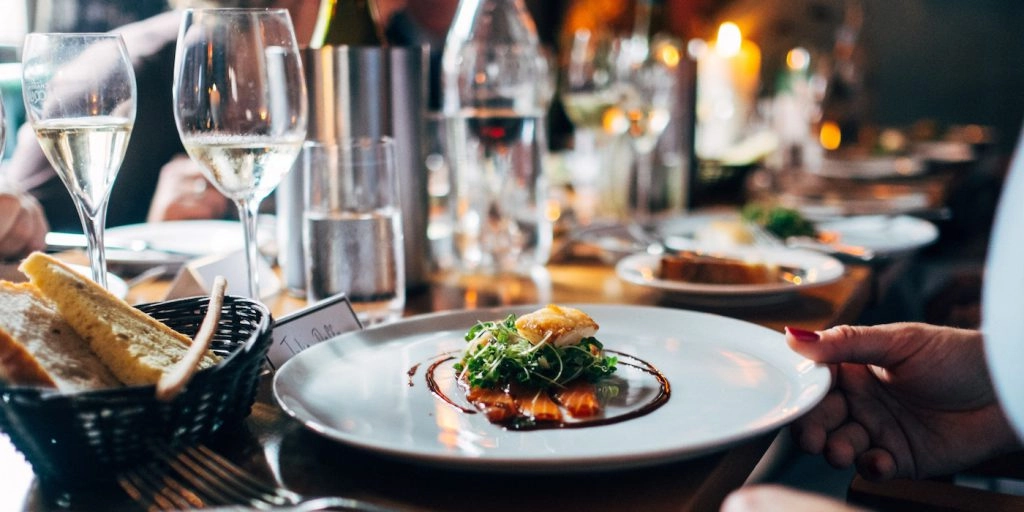One of the most common questions that people in the wine industry hear is “what food will go well with this wine?” The answer to this topic has been thrown back and forth between sensory analysts for years, but now most can agree with at least a few basic guidelines to food and wine pairing. All food affects the sensory aspects of the wine you drink. Sometimes the food you eat can create a better sensory experience than the wine could have by itself, but often eating certain foods with an already well balanced wine can bring out negative aspects that would not have otherwise been noticeable.
There are several different effects that food can have on your taste buds, depending on the chemical composition that is in them. For instance, a food that is naturally bitter such as dark chocolate will increase your perception of bitter flavors and astringent mouth feel not usually found in that particular wine. So instead of serving dark chocolate with a tannic red wine, you might want to try milk chocolate with your red. But while many foods can cause bitterness to increase in perception, there are others that can delightfully decrease it. One of my favorite breakfast dishes is Eggs Benedict with Julia Child’s Hollandaise sauce. I have many fond childhood memories of waking up to the sound of my mother whisking away at the stove. And much to my delight, it has been discovered that Hollandaise sauce can decrease the tastes of sourness and bitterness sometimes found in oaky Chardonnay. So while this information does not necessarily give you the excuse to drink Chardonnay on a Sunday morning, it is a good idea to consider using the sauce on bitter vegetables in order to counteract the bitter flavors that would otherwise be expressed.

Another common pairing of flavoring found in food that can affect wine is salty and sour. Items such as the salt and lemon juice found in most lemon caper chicken recipes can also eradicate bitter taste found in wines as well as decrease the ability for the consumer to taste the sourness in the wine. After eating a food with salt and citric acid, the ability to perceive sourness in the wine decreases, leaving a sweeter tasting wine that should have a richer and mellower mouth feel.
Of course having too much acidity in the food is not a good idea either. It has been known in the wine world, for some time, that acid rich foods such as tomatoes and tomato based sauces have such a high acid level that they decrease the consumer’s ability to taste acid in the wine. This causes the wine to appear flat and flabby. So, if you were to go out to classic Italian restaurants, you will notice that the most common wines served with tomato based dishes are highly acidic Chianti Classicos and other high acid wines that will still taste balanced.
Another classic example of a food that renders the wine flat and sweet as soda is the artichoke. This vegetable is commonly prepared in restaurants and shown in recipes in food articles. An artichoke can be a big part of a delicious and perfect meal; just don’t pull out your best bottle of wine after eating one. These beauties have a huge effect on the chemistry of your taste buds. The chemical in question is known as cynarin, and it directly blocks taste buds that detect sweetness. When you eat or drink after biting into an artichoke the cynarin is washed off of the taste bud and the difference in the perception of sweetness increases exponentially. This reaction even makes water taste like it has been spiked with sugar. So, you can see why the cynarin in your steamed artichoke can cause a normally balanced wine to appear as sweet as our Leannan label. As an alternative to counter balance this food with your wine, it is commonly suggested to pour a high acid and very dry wine. This way a little added sweetness does not ruin the balance of the wine with your delicious artichoke dish.
In contrast to foods that make your dinner wine taste abnormally sweet, other foods can take away your ability to perceive sweetness. Any food that has a high level of sugar or a sweet taste will suppress your tongue’s ability to detect sweetness in the wine. In fact your wine will become more sour, bitter, less fruity and astringent than it would if you were to drink it without consuming food at all.
The last palate changing flavor that I’m going to talk about is all the rage in sensory analysis. This fifth taste is called “umami”, and in simple terms it means savory. When most of us say savory we think of comfort foods with flavors such as chicken broth, mushrooms, parmesan cheese, blue cheese, and soy sauce. While foods that are considered umami flavors can be delicious, they tend to have an upsetting effect on the wine that is consumed with them. Umami tends to bring out characteristics of bitter and even metallic flavors in wine. Unless it is counteracted with a food that will decrease bitterness, umami has the potential to bring a paired wine out of balance and make it less enjoyable.
All of these palate changing foods and flavors I have talked about today should be taken with perspective. No amount of hollandaise sauce is going to better the balance of a two dollar chardonnay and make it taste like a fifty dollar chard. And eating dark chocolate with a red wine will probably not cause you to make a face like a kid trying black coffee for the first time. To the common drinker, these changes in perception are rather subtle and small enough to still enjoy most wines with most recipes. To the avid wine connoisseur, these changes in palate can be big enough to change dinner menus. It all depends on what kind of wino that you are. Food For Thought.



Leave a Reply